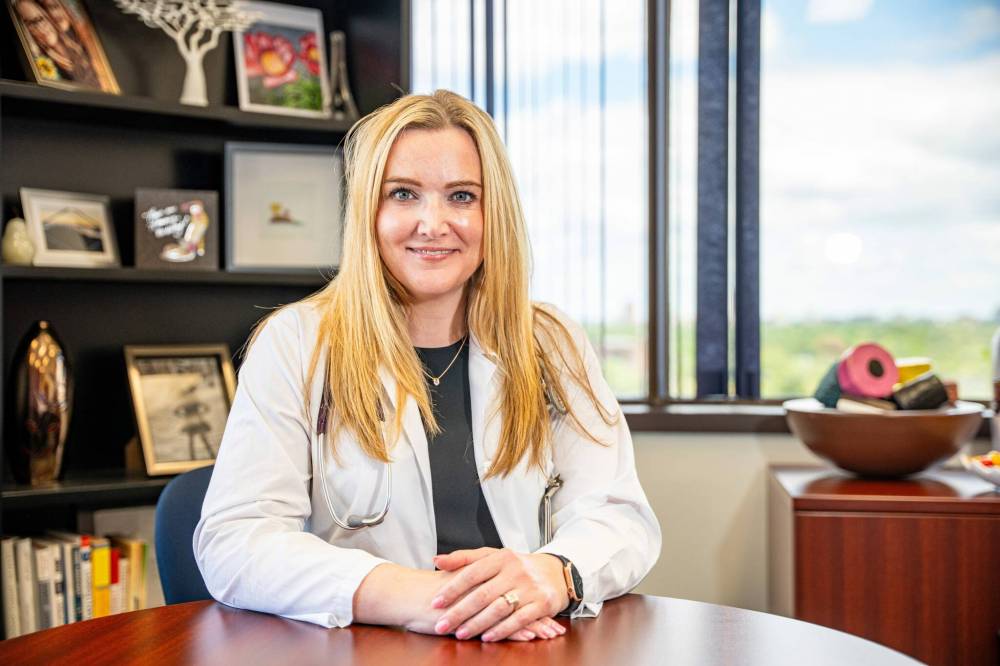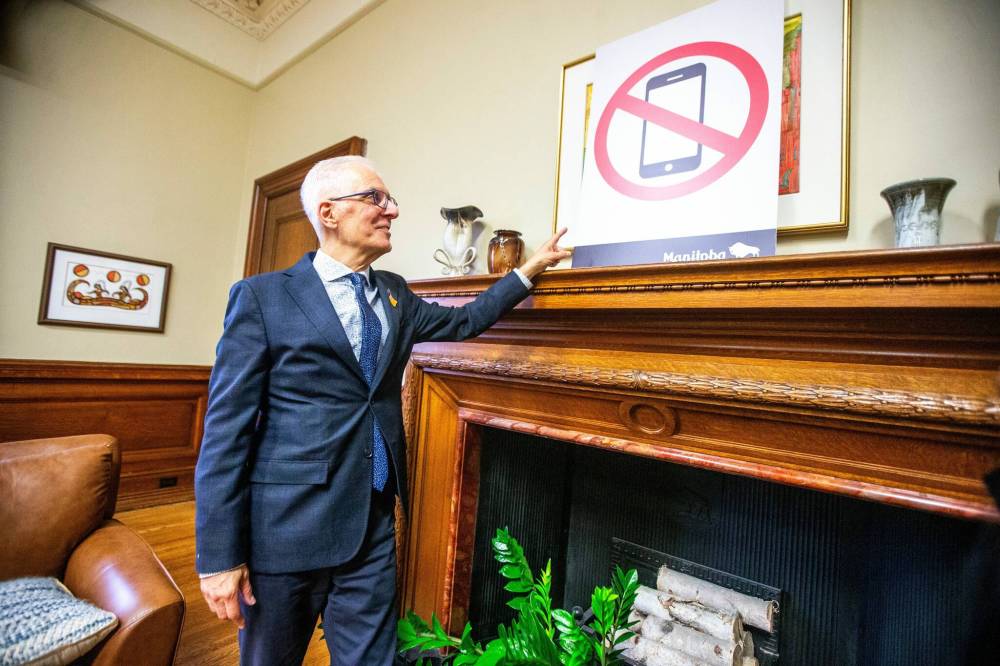Manitoba physicians are being reminded about the “serious responsibility” of issuing medical notes as schools enforce a new cellphone ban, with exemptions for health- and inclusion-related reasons, this week.
“This is a very large social change, an abrupt social change, and so I think there may be lots of conversations in doctors’ offices about concerns,” said Dr. Ainslie Mihalchuk, registrar and chief executive officer of the College of Physicians and Surgeons of Manitoba.
The regulatory body issued a memo to pediatricians and their colleagues in the lead-up to the school year — the first of its kind with universal restrictions on phone usage.

NIC ADAM / FREE PRESS FILES
Dr. Ainslie Mihalchuk, registrar and chief executive officer of the College of Physicians and Surgeons of Manitoba says her office has received questions about exemptions from the new cellphone ban.
The education department announced last month that, starting this fall, elementary schools would be phone-free zones and high schoolers would be subject to stricter rules to limit screen time and learning distractions.
Kindergarten-to-Grade 8 students are being asked to leave their personal devices at home. Teenagers will only be allowed to use phones during breaks and when explicitly instructed to do so for educational purposes.
Mihalchuk said her office has received questions about exemptions and wanted to proactively address the matter because doctors may see increased requests for formal notes, not unlike when schools introduced mask requirements during the COVID-19 pandemic.
Manitoba’s 38 school boards are responsible for updating their respective policies in line with the order.
“This is a very large social change, an abrupt social change, and so I think there may be lots of conversations in doctors’ offices about concerns.”–Dr. Ainslie Mihalchuk
The college’s advice, published on Aug. 28, reminds doctors to conduct an objective clinical assessment before issuing a note and document their rationale in the patient’s medical record.
It acknowledges the use of apps that continuously monitor sugar levels for students with diabetes and other requests that “may not be as clear-cut and will require clinical judgment.”
Darlene Bromley said her concern lies not in the approval of phone-use for her granddaughter — an eight-year-old who relies on a diabetes management app that provides real-time data — but rather the social implications for students with exemptions.
“Bullying — that is the biggest concern, from either other peers or other parents who don’t understand the need for this medical device. It’s a lack of understanding,” Bromley said.
The Winnipeg grandmother warned that a lack of public education on the importance of tools, such as the Dexcom tool used by her family, could further marginalize students with Type 1 diabetes and other health conditions.
“Educating the public is really important and acknowledging it beforehand so kids aren’t getting backlash from this and having to deal with explaining it on their own because that’s not something they should have to (do),” she said.
Critics of the ban have expressed concerns ranging from its impact on teacher autonomy to the challenges it poses for caregivers who want to be in frequent contact with their children on weekdays.
One teacher said he fears the changes will create more problems because many students, especially those with diagnosed and undiagnosed ADHD and FASD, regulate themselves by listening to music on their phones.
“When we take this away from them, we are creating a void that most teachers are not equipped to fill.”–Anonymous teacher
“For many students, these devices are inclusion technology. It might be inclusion to access the content or its inclusion in being able to exist in the space,” said the teacher, who spoke to the Free Press on the condition of anonymity.
“When we take this away from them, we are creating a void that most teachers are not equipped to fill.”
He noted that classrooms can be dysregulating spaces due to uncomfortable furniture, limited or few windows, hot temperatures and, at times, an echoing effect inside them.
Education Minister Nello Altomare has touted the announcement as one that will limit learning distractions and promote face-to-face socialization.
Schools have been asked to accommodate students with individualized plans, including but not limited to those requiring translation apps, Altomare said.

Mikaela MacKenzie/ Free Press Files
Education Minister Nello Altomare shows school signage related to the cellphone ban in his office at the Manitoba Legislative Building.
The minister noted that divisions will tailor policies to meet their needs, but he called the prospect of requiring a parent to obtain a doctor’s note to use a cellphone at school “ridiculous.”
“(The ban) will benefit the kids who don’t either have the structure at home to decrease screen-time and it also allows for children to learn, I think, social communication in a better, in-person way and not zone-out on phones,” said Dr. Jennifer Coombs.
The pediatrician said she is constantly in conversation with parents about excessive screen time, what leads to it, and how to model a healthy relationship with digital devices.
In her Winnipeg office, she has a poster touting the “5-2-1-0” rule to promote a healthy, active lifestyle among patients. The two stands for the maximum amount of time that children and youth should spend in front of a screen on a daily basis.
(The five refers to the amount of fruit and vegetables that should be consumed daily while the one is a nod to an hour of physical exercise and the zero emphasizes that students should not consume sugar-sweetened drinks.)
Coombs has yet to receive a request for a phone exemption and suggested they will be few and far between because schools manage student medical conditions via URIS (Unified Referral and Intake System).
Janet Connors credited the provincial database and staff at her son’s St. James high school for setting up a seamless transition to Grade 10 despite the phone ban.
The 14-year-old’s file indicates he can use his phone to manage glucose levels throughout the day and communicate with his mother about anything related to his Type 1 diabetes, Connors said.
“His phone has saved his life more times than I can count and it doesn’t matter to me how many times it’s been distracted in the classroom,” she said. “That tool outweighs all of the negatives.”
maggie.macintosh@freepress.mb.ca

Maggie Macintosh
Education reporter
Maggie Macintosh reports on education for the Free Press. Originally from Hamilton, Ont., Maggie was an intern at the Free Press twice while earning her degree at Ryerson’s School of Journalism (now Toronto Metropolitan University) before joining the newsroom as a reporter in 2019. Read more about Maggie.
Funding for the Free Press education reporter comes from the Government of Canada through the Local Journalism Initiative.
Every piece of reporting Maggie produces is reviewed by an editing team before it is posted online or published in print — part of the Free Press‘s tradition, since 1872, of producing reliable independent journalism. Read more about Free Press’s history and mandate, and learn how our newsroom operates.
Our newsroom depends on a growing audience of readers to power our journalism. If you are not a paid reader, please consider becoming a subscriber.
Our newsroom depends on its audience of readers to power our journalism. Thank you for your support.